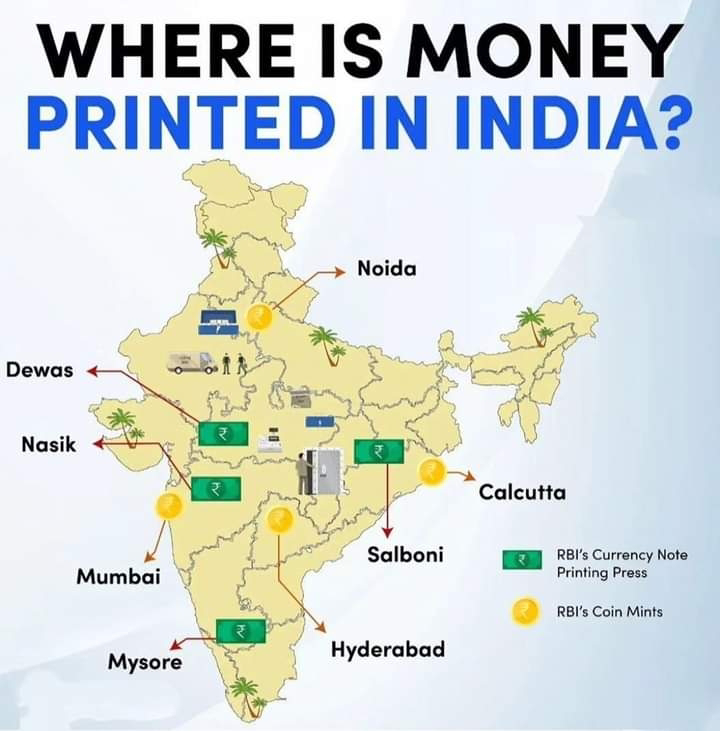Safeguarding India's Monetary Ecosystem: Unveiling Currency Printing Centers and Coin Mints
Safeguarding India's Monetary Ecosystem: Unveiling Currency Printing Centers and Coin Mints
Introduction:
A nation's currency and coins play a vital role in its economic stability and growth. India's monetary ecosystem is supported by the Reserve Bank of India (RBI) and the Security Printing and Minting Corporation of India Limited (SPMCIL), both of which operate currency printing centers and coin mints across the country. In this comprehensive report, we explore the locations, operations, and significance of these currency printing centers and coin mints in India's financial landscape.
Currency Printing Centers:
Nashik Currency Note Press, Nashik, Maharashtra:
Established in 1928, the Nashik Currency Note Press is a cornerstone of India's currency production. Situated in Nashik, Maharashtra, this state-of-the-art facility employs advanced printing technology and stringent security measures to meet the nation's burgeoning demand for currency notes.
Data:
Production Capacity: 16 billion currency notes per year
Security Features: Watermarks, security threads, and intaglio printing
Workforce: Over 1,000 skilled workers and technicians
Bank Note Press, Dewas, Madhya Pradesh:
Founded in 1974, the Bank Note Press in Dewas, Madhya Pradesh, supplements the country's currency production capacity. Equipped with cutting-edge technology, this printing center is staffed by skilled personnel, contributing significantly to the fulfillment of India's currency needs.
Data:
Production Capacity: 12 billion currency notes per year
Security Features: Color-shifting ink, microlettering, and optically variable ink
Workforce: Approximately 2,000 trained staff members
Bharatiya Reserve Bank Note Mudran Private Limited (BRBNMPL):
A wholly-owned subsidiary of RBI, BRBNMPL operates two currency printing facilities:
a. BRBNMPL, Mysuru, Karnataka:
Established in 1995, the Mysuru facility enhances India's currency production capabilities. Using high-speed currency printing machines, it ensures efficient and secure production.
Data:
Production Capacity: 16 billion currency notes per year
Security Features: Micro-optic security, iridescent bands, and machine-readable features
Workforce: Over 1,500 skilled workforce
b. BRBNMPL, Salboni, West Bengal:
Inaugurated in 2015, the Salboni facility caters to the currency needs of the eastern region of India. It has been instrumental in meeting the increasing demand for currency notes.
Data:
Production Capacity: 10 billion currency notes per year
Security Features: Latent images, fluorescent inks, and microprinted lines
Workforce: Around 1,000 trained personnel
Security Printing and Minting Corporation of India Limited (SPMCIL):
In addition to the RBI-operated printing centers and BRBNMPL facilities, SPMCIL, a government-owned company, plays a significant role in currency production.
a. Currency Note Press, Nashik Road, Maharashtra:
Established in 1990, this printing facility complements the Nashik Currency Note Press operated by the RBI. It utilizes modern printing technology to produce high-quality currency notes.
Data:
Production Capacity: 10 billion currency notes per year
Security Features: Optically variable ink, intaglio features, and tactile marks
Workforce: Over 1,200 skilled workforce
Coin Mints:
Mumbai Mint, Mumbai, Maharashtra:
The Mumbai Mint, located in Mumbai, Maharashtra, holds the distinction of being India's oldest functioning mint. Since its establishment in 1829, it has played a pivotal role in manufacturing coins for the country.
Data:
Production Capacity: 2.5 billion coins per year (approximately)
Security Features: Unique designs and metal compositions for various denominations
Workforce: A dedicated team of skilled minting professionals
Kolkata Mint, Kolkata, West Bengal:
Established in 1757, the Kolkata Mint stands as a historical landmark and an important minting center. It caters to the coin needs of eastern India.
Data:
Production Capacity: 1.5 billion coins per year (approximately)
Security Features: Distinctive designs and metallic compositions for different coin denominations
Workforce: Skilled workforce ensuring efficient coin minting operations
Conclusion:
India's currency printing centers and coin mints form the backbone of the nation's monetary infrastructure. Through advanced technology, stringent security measures, and skilled workforces, these centers ensure the continuous supply of currency notes and coins to meet the diverse monetary requirements of the Indian economy. Their significance in safeguarding India's financial stability and fostering trust in its currency cannot be overstated.




Comments
Post a Comment